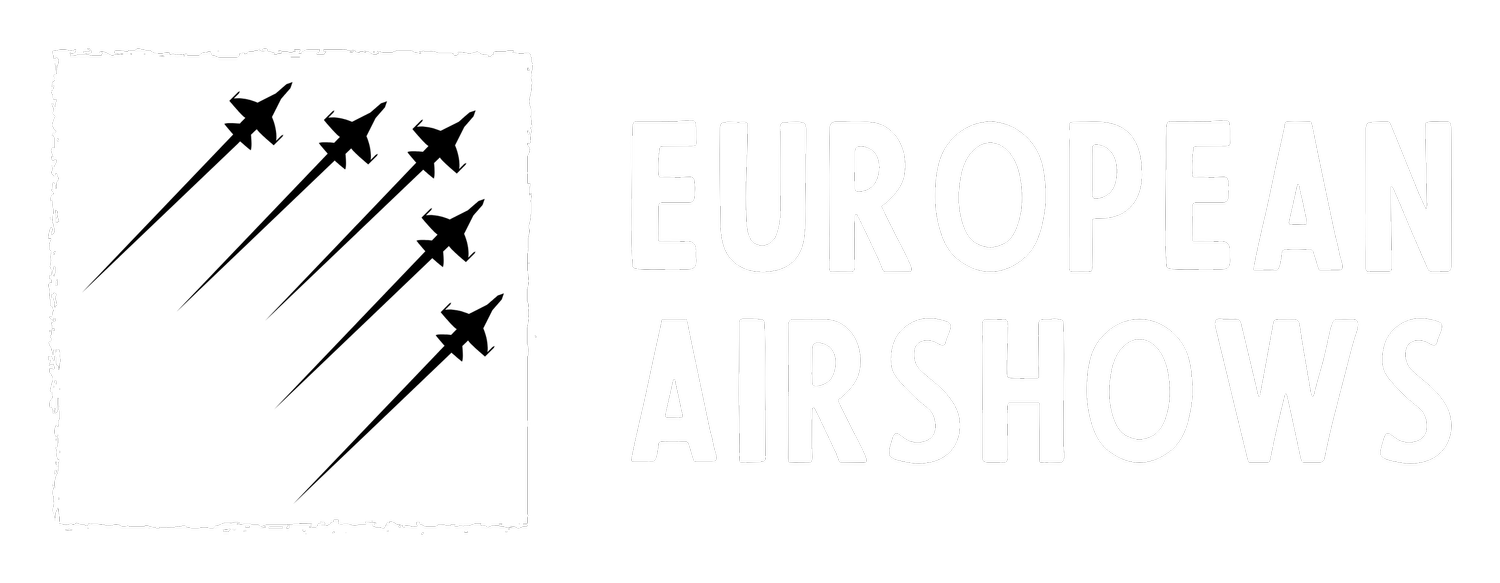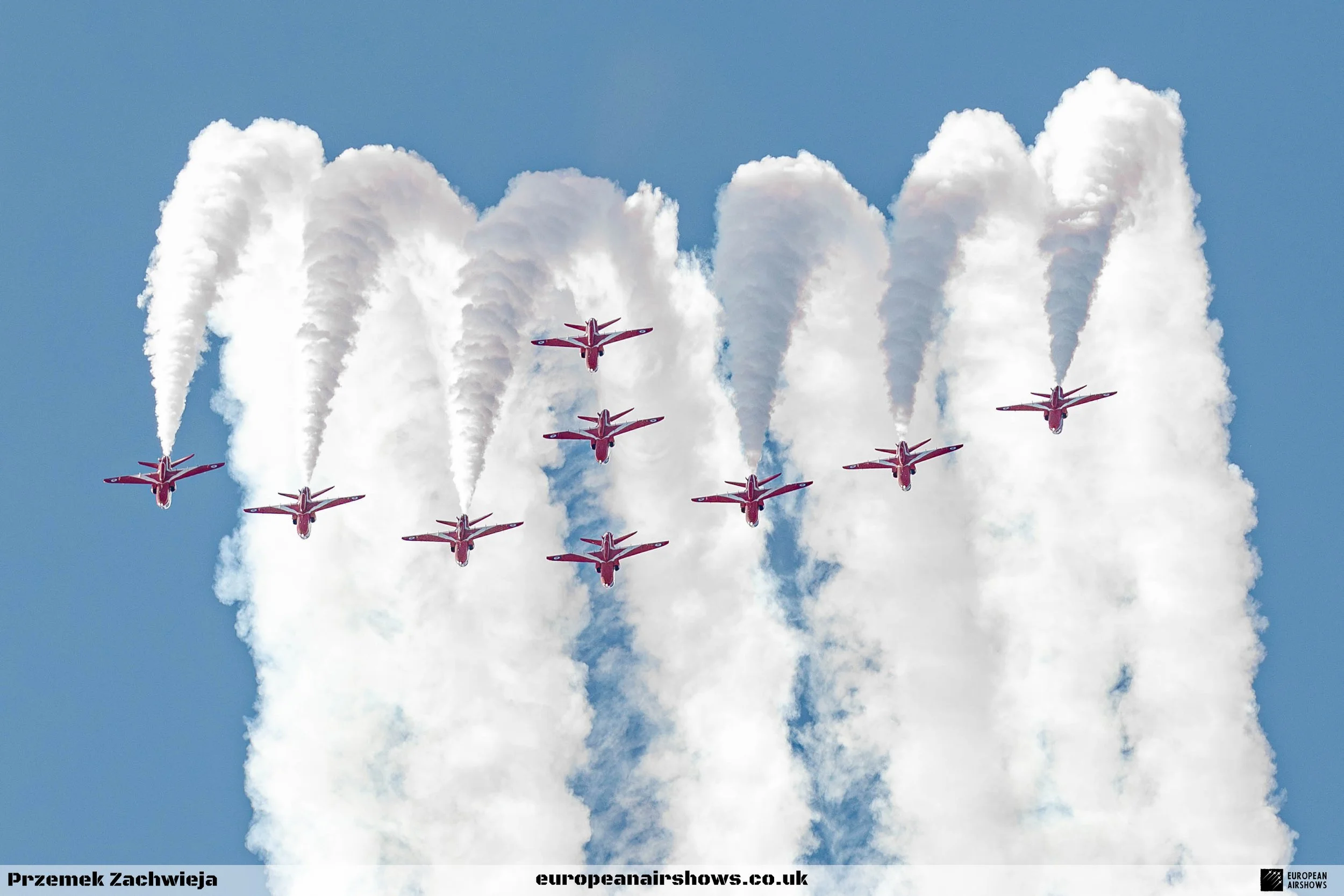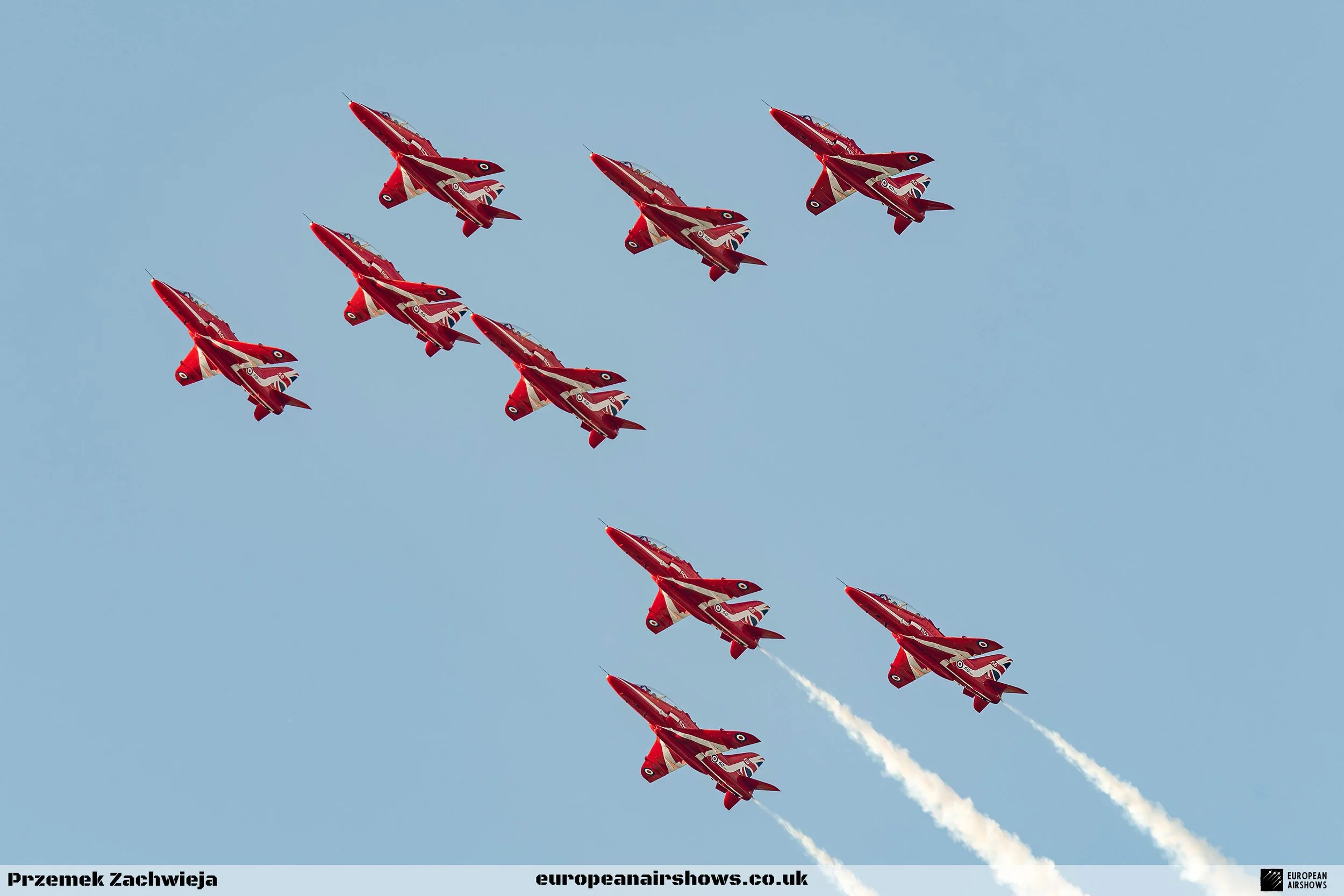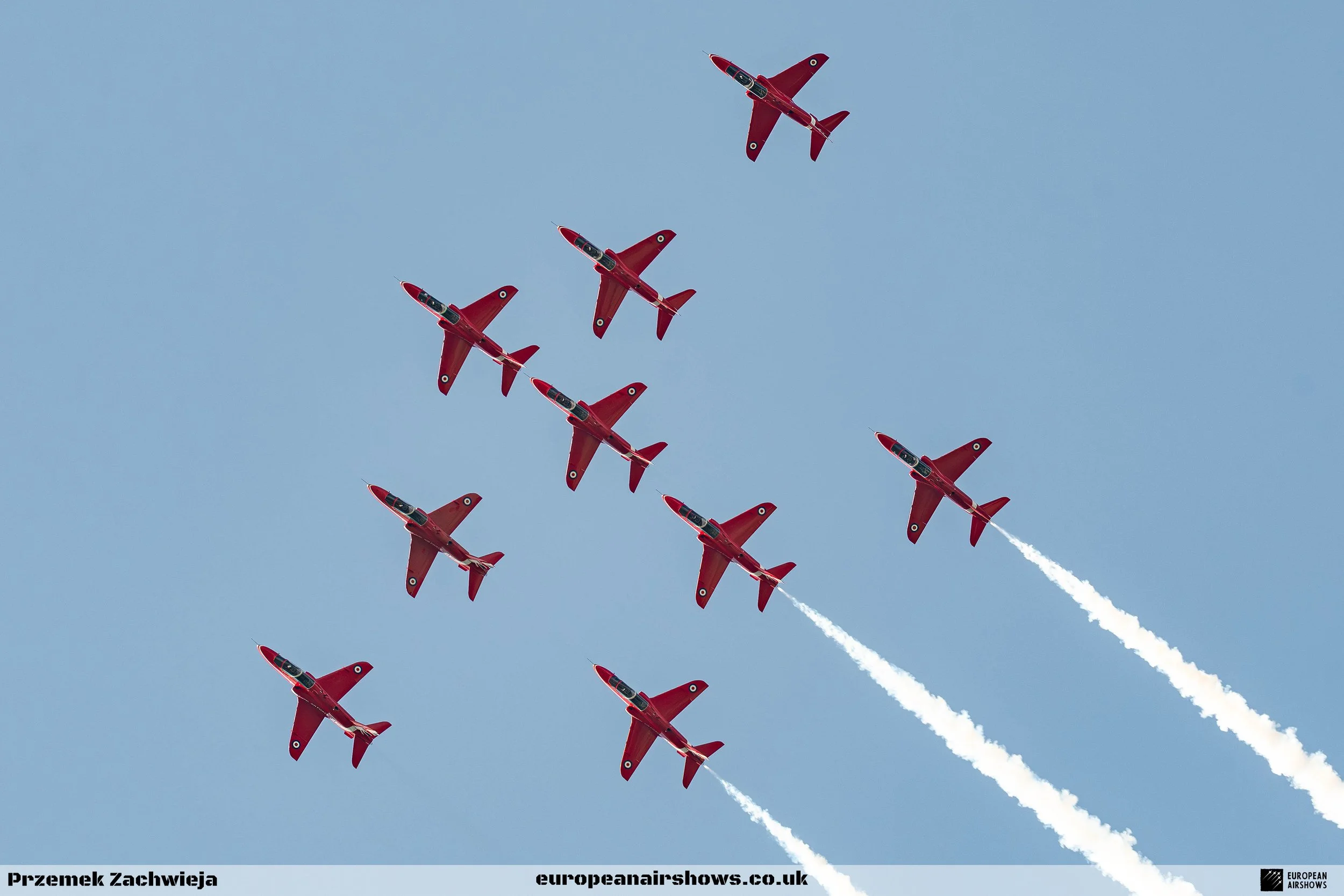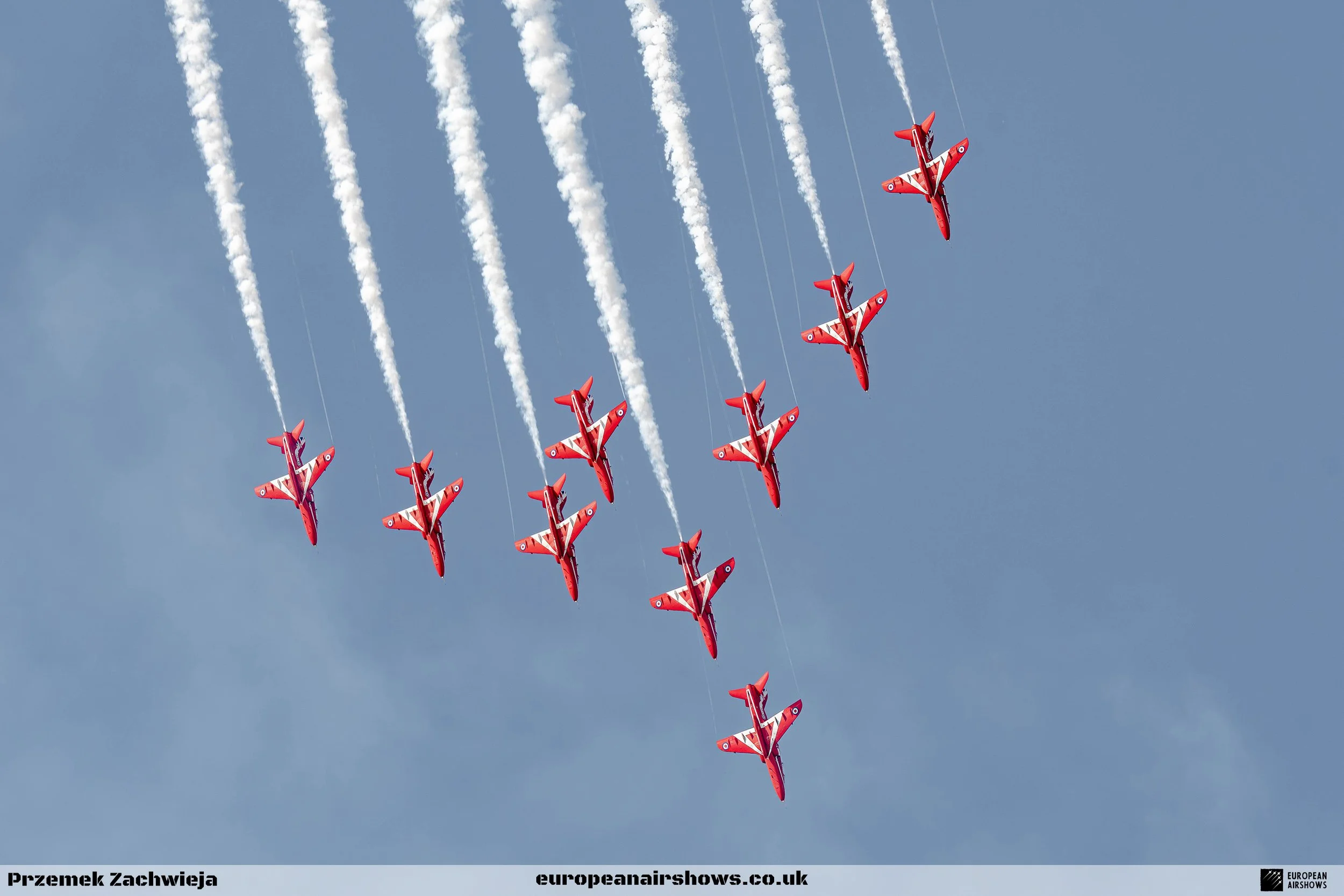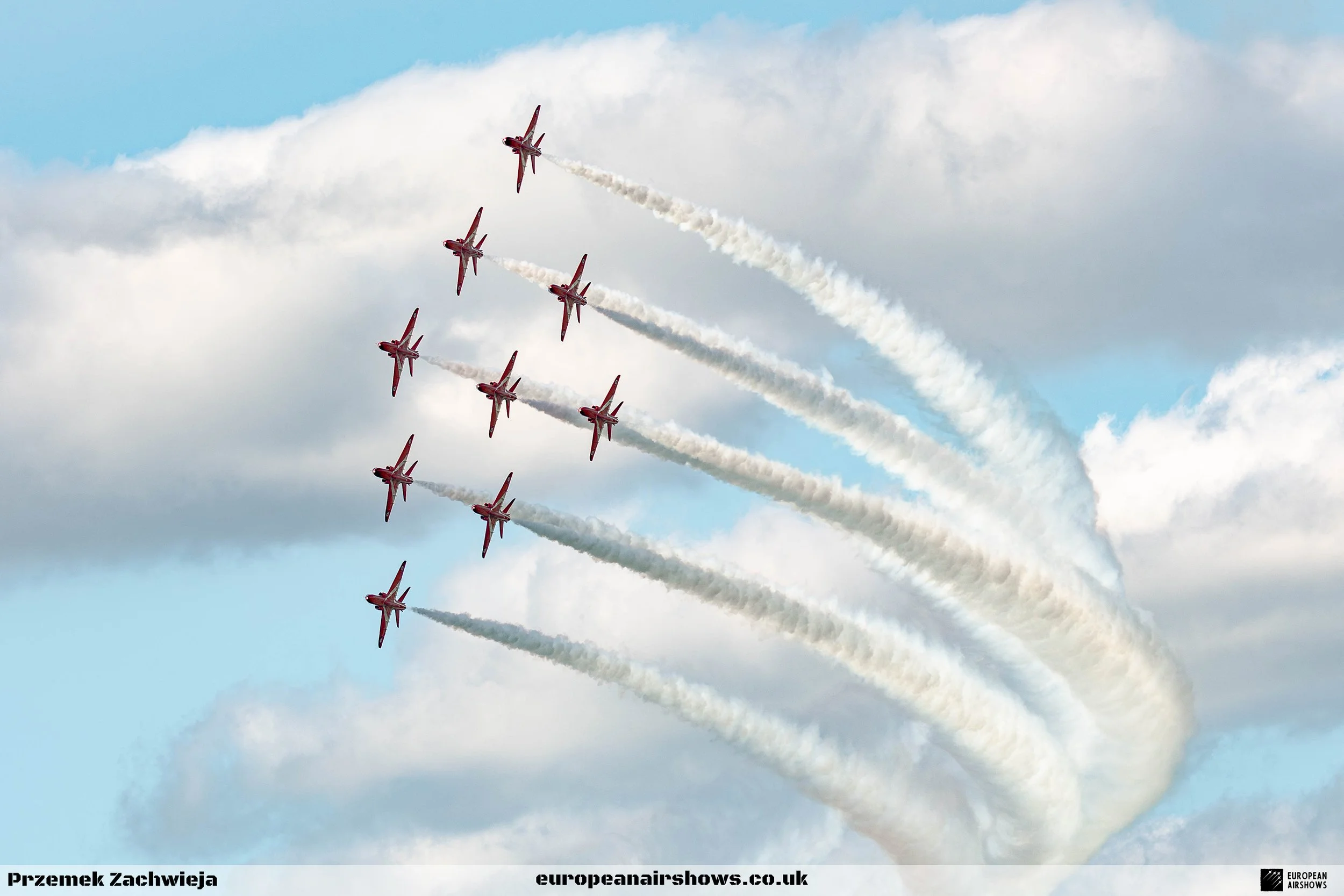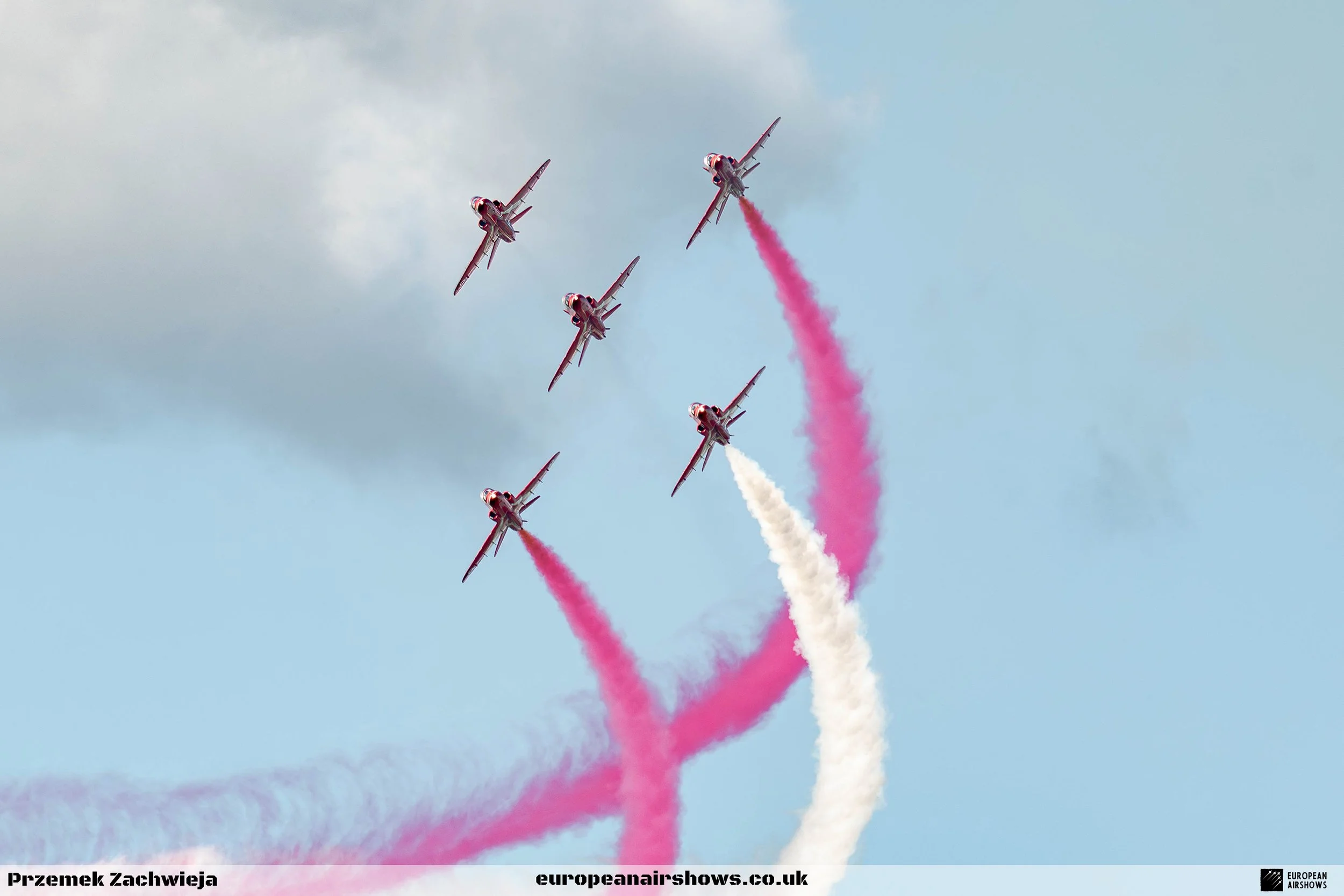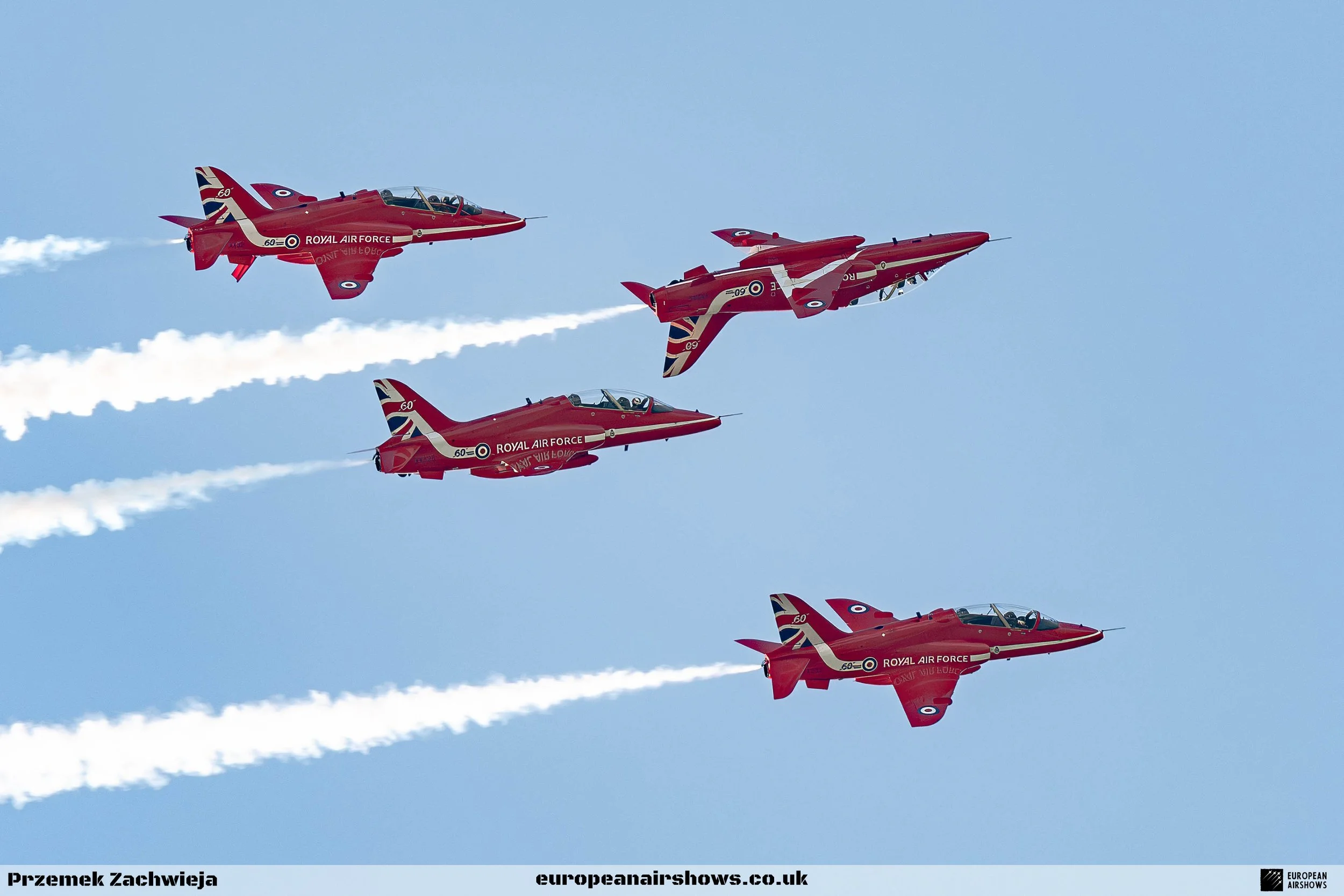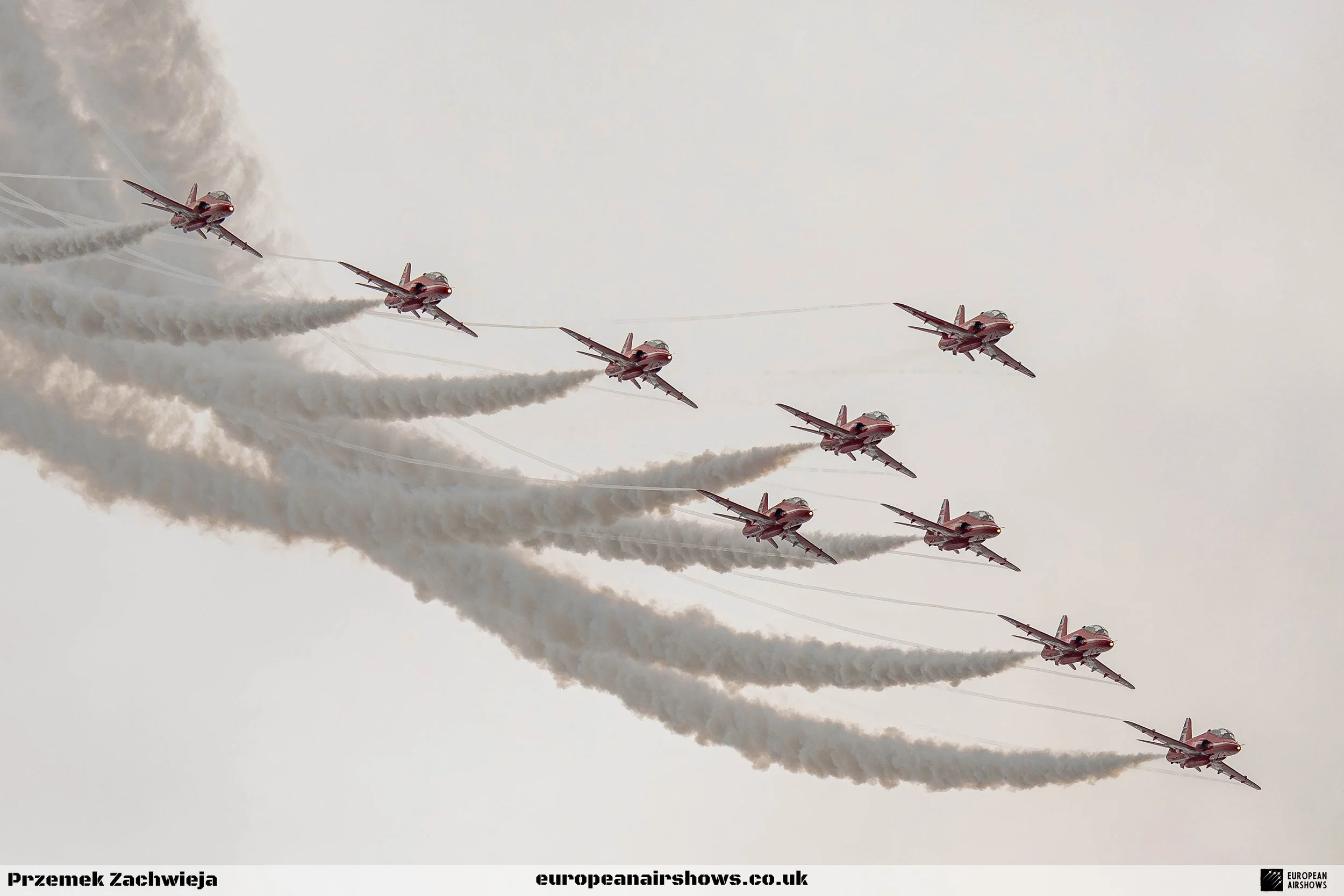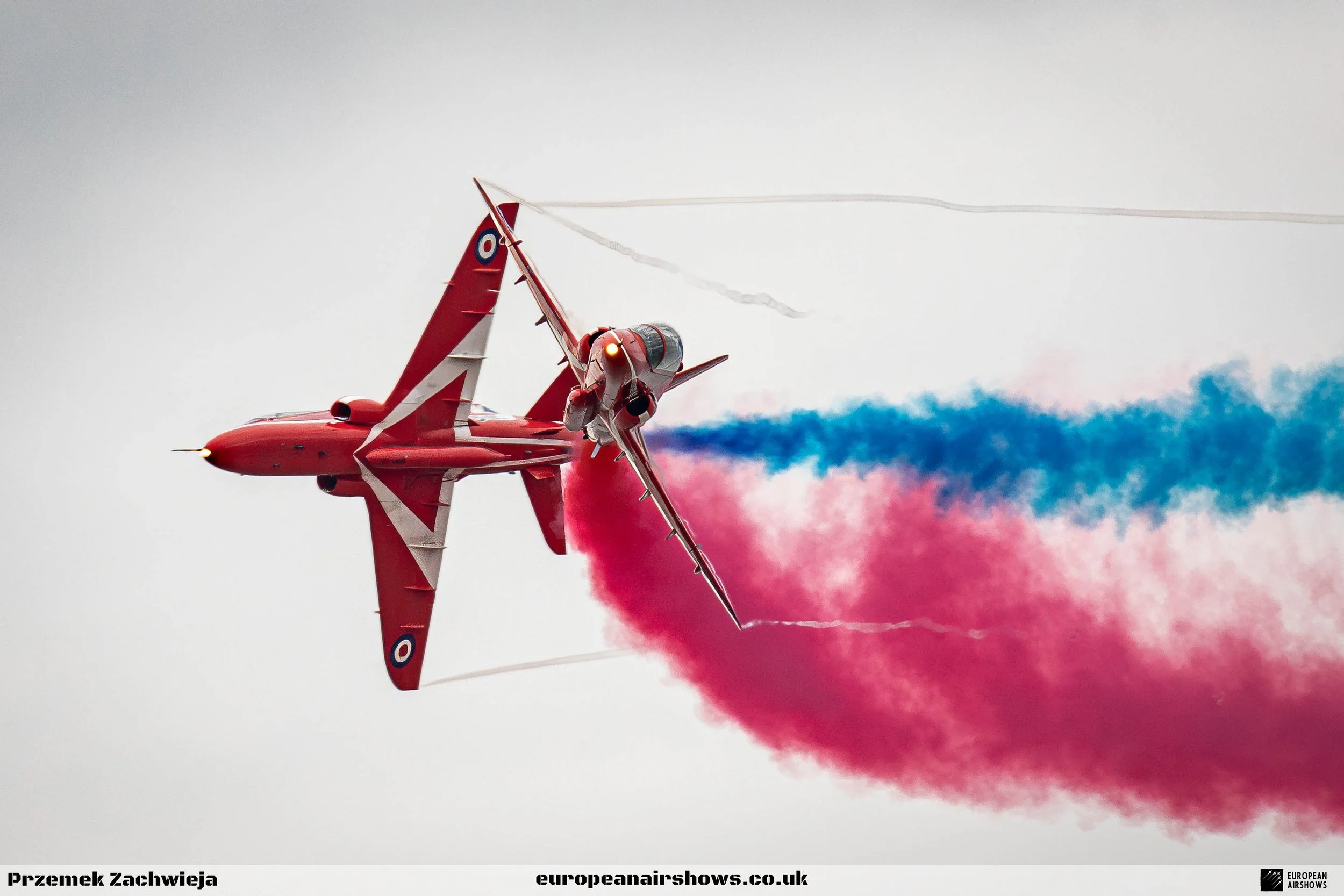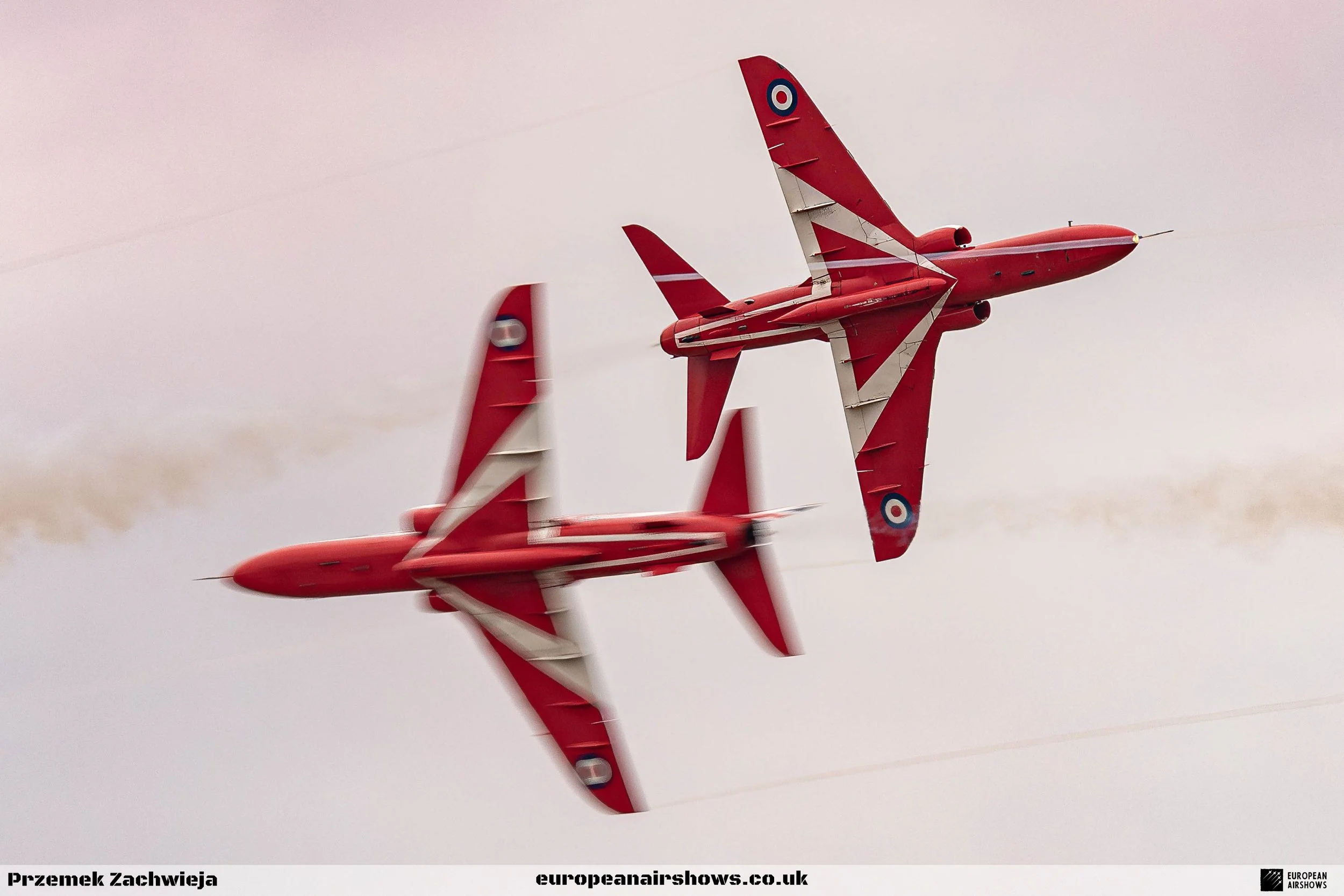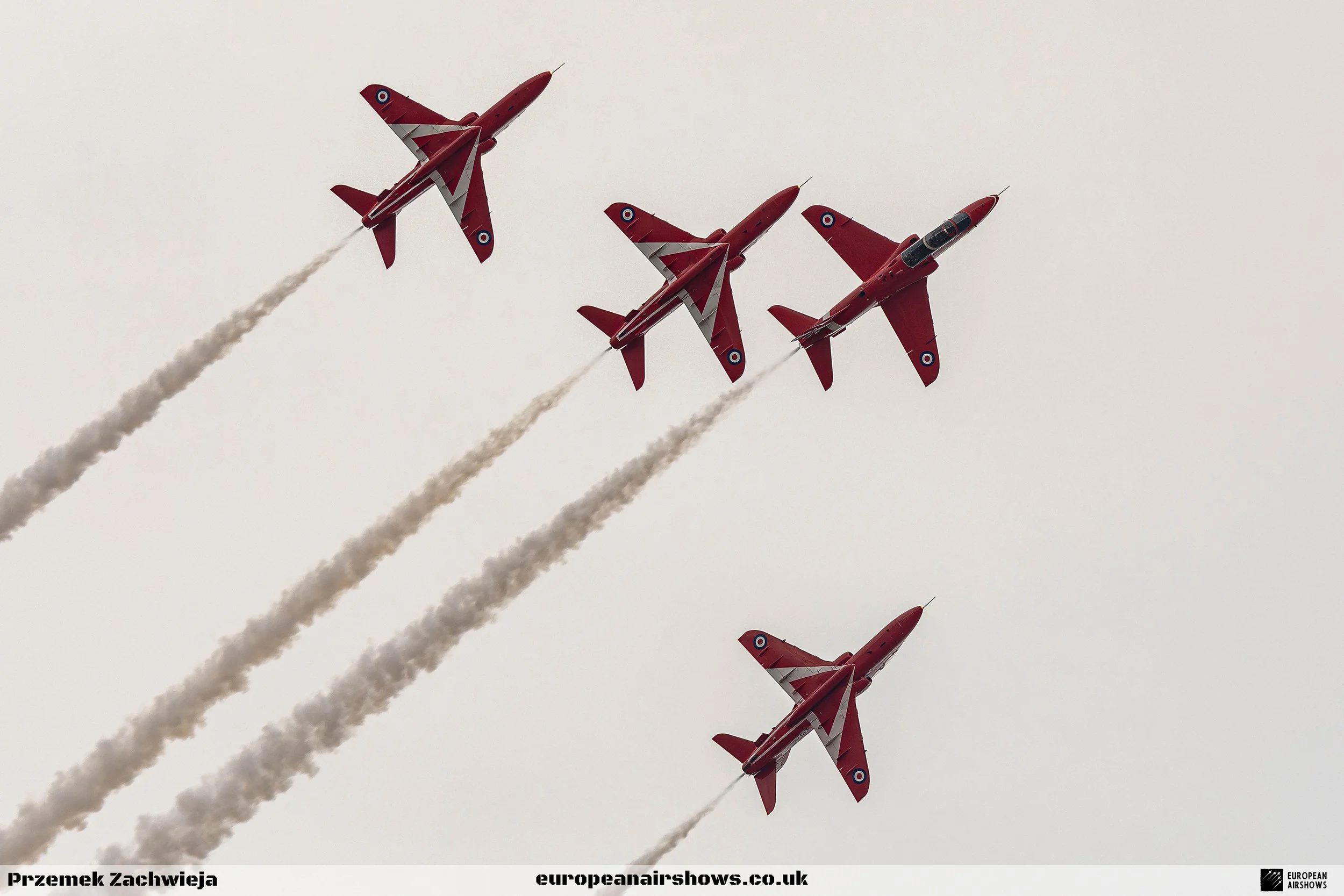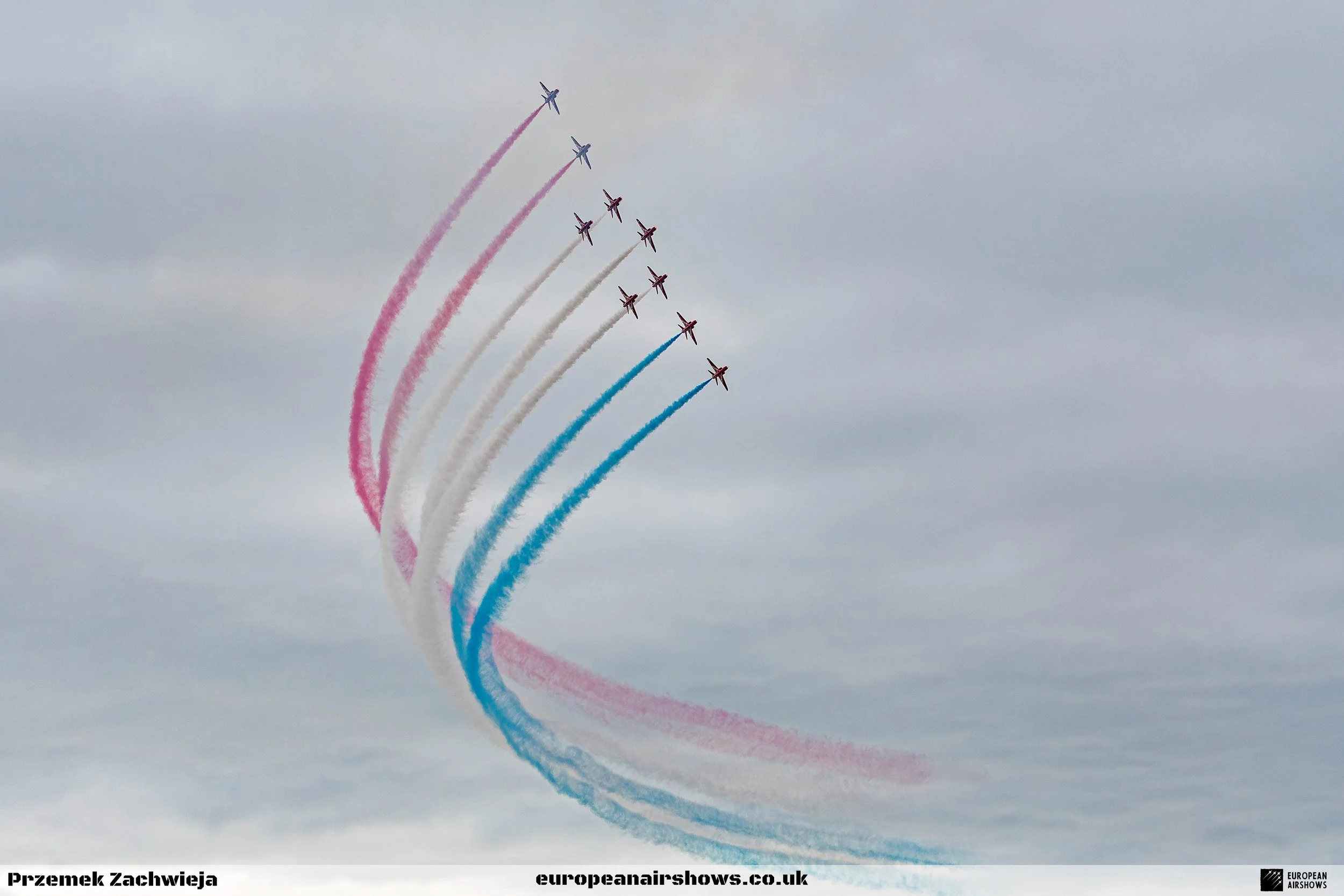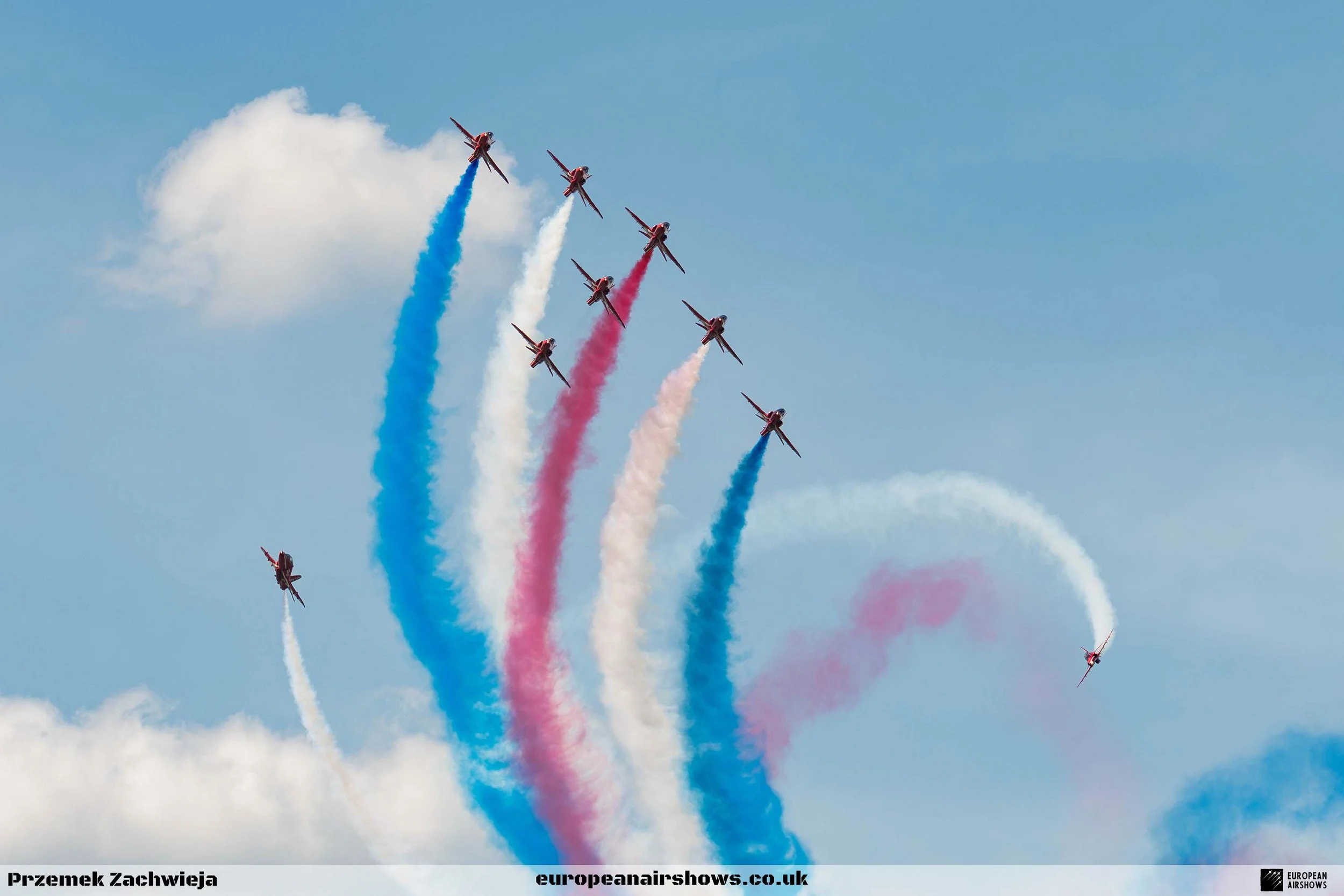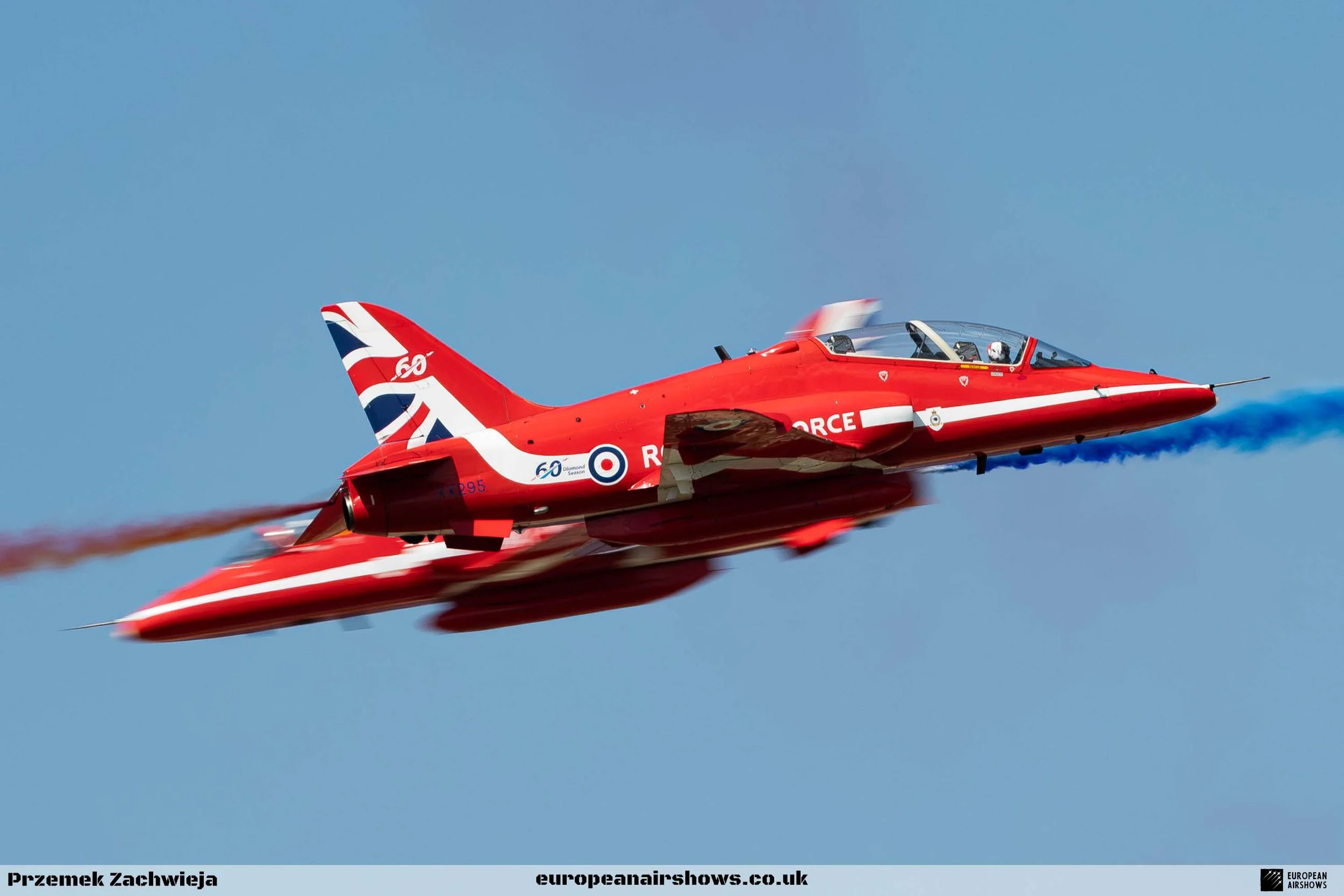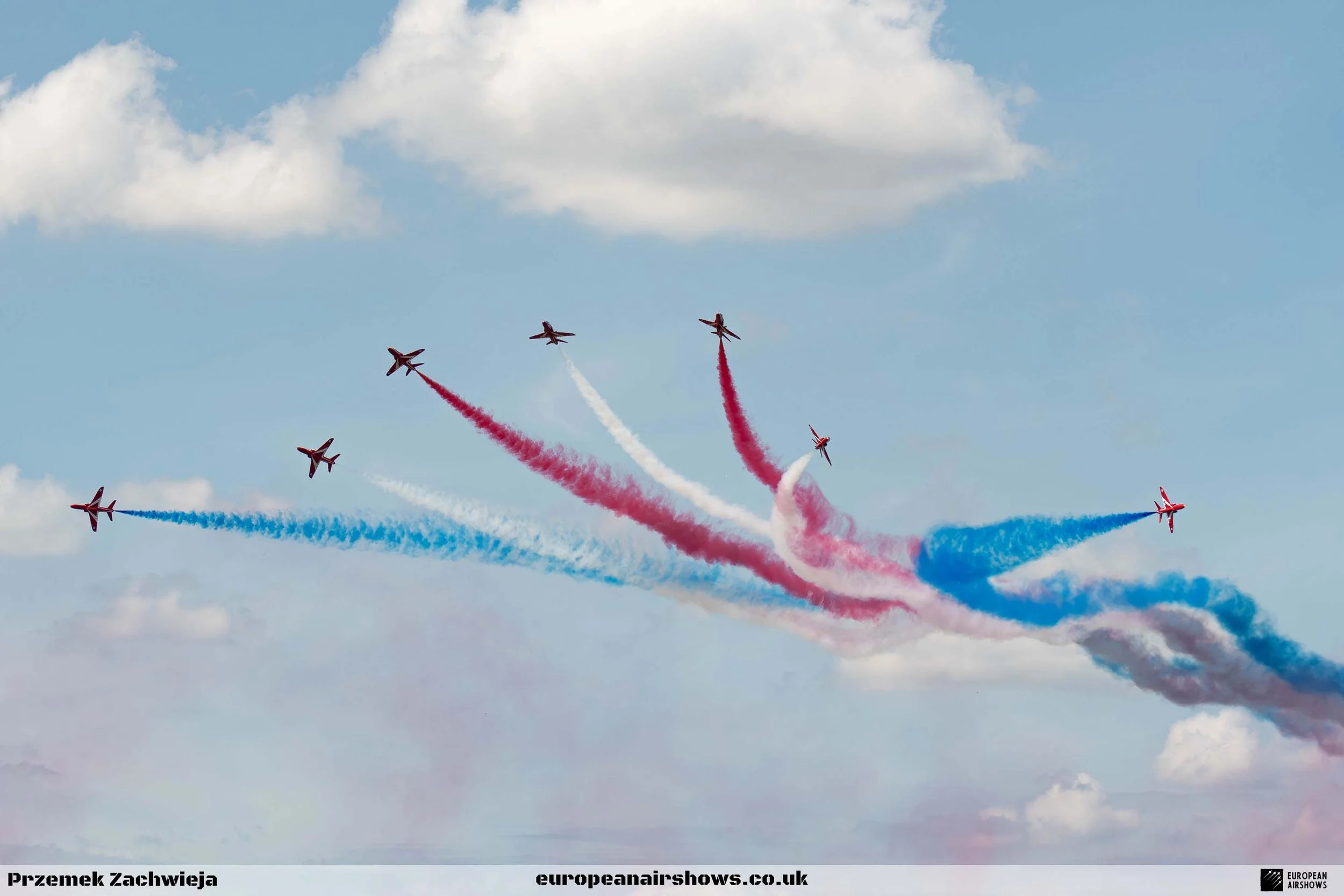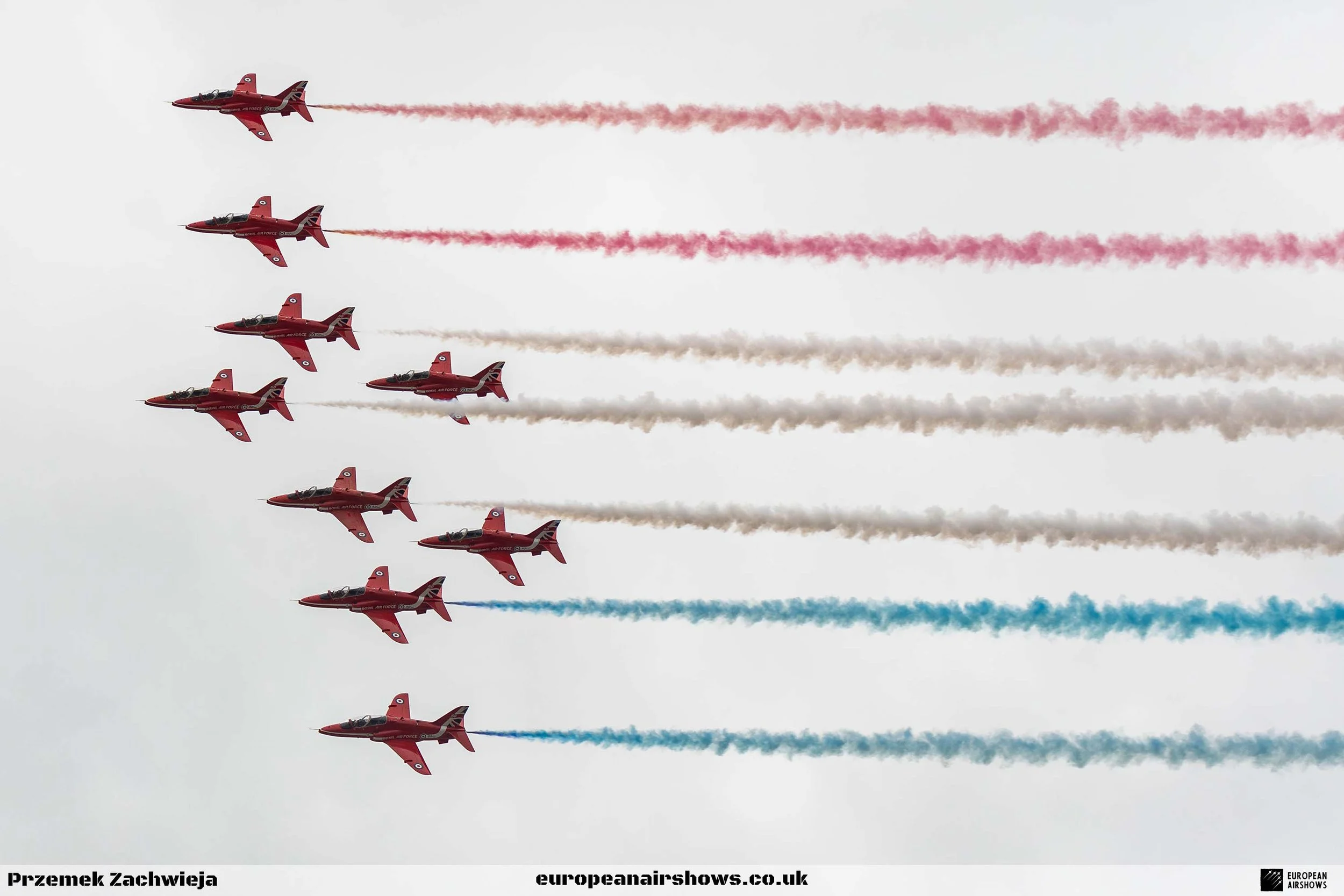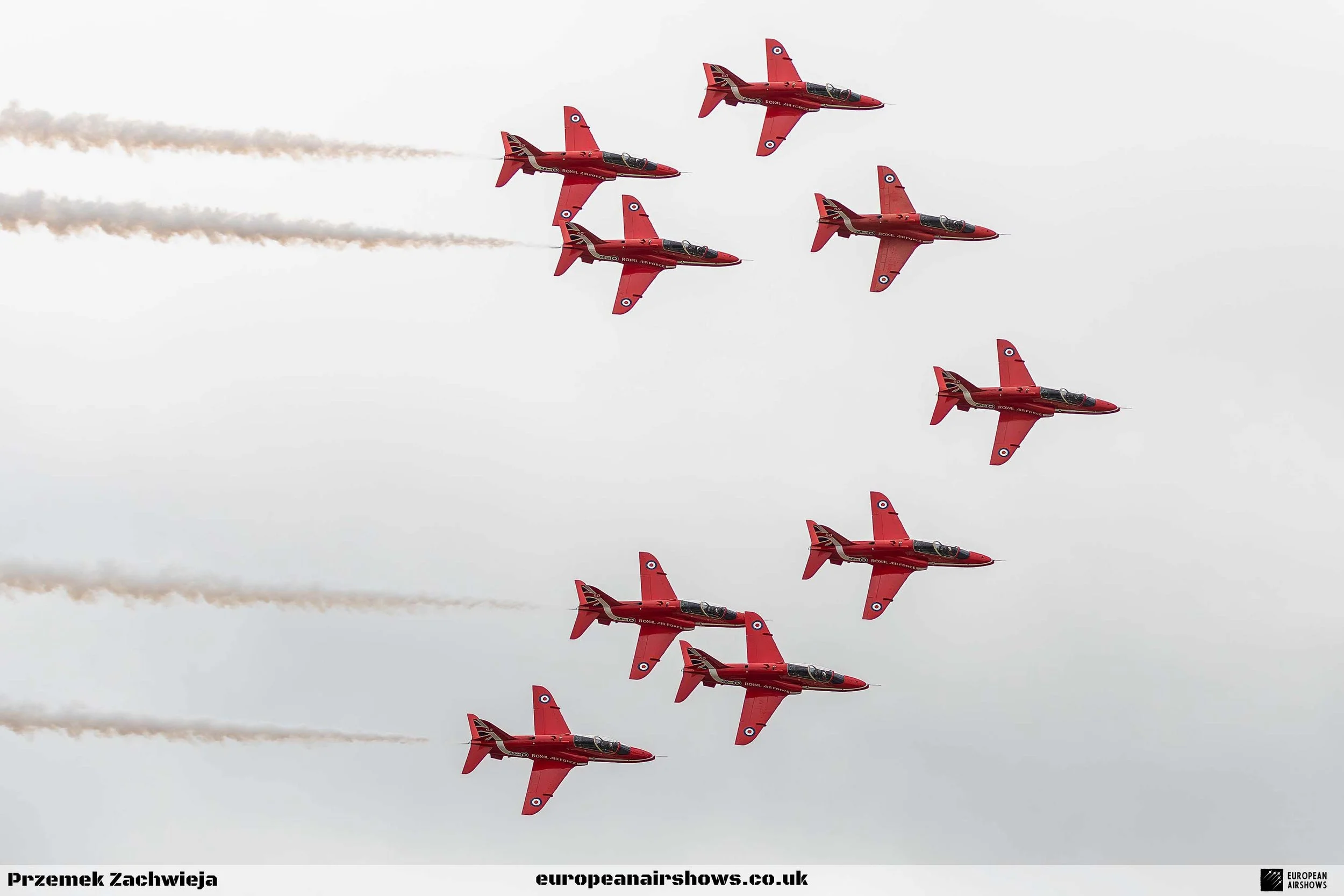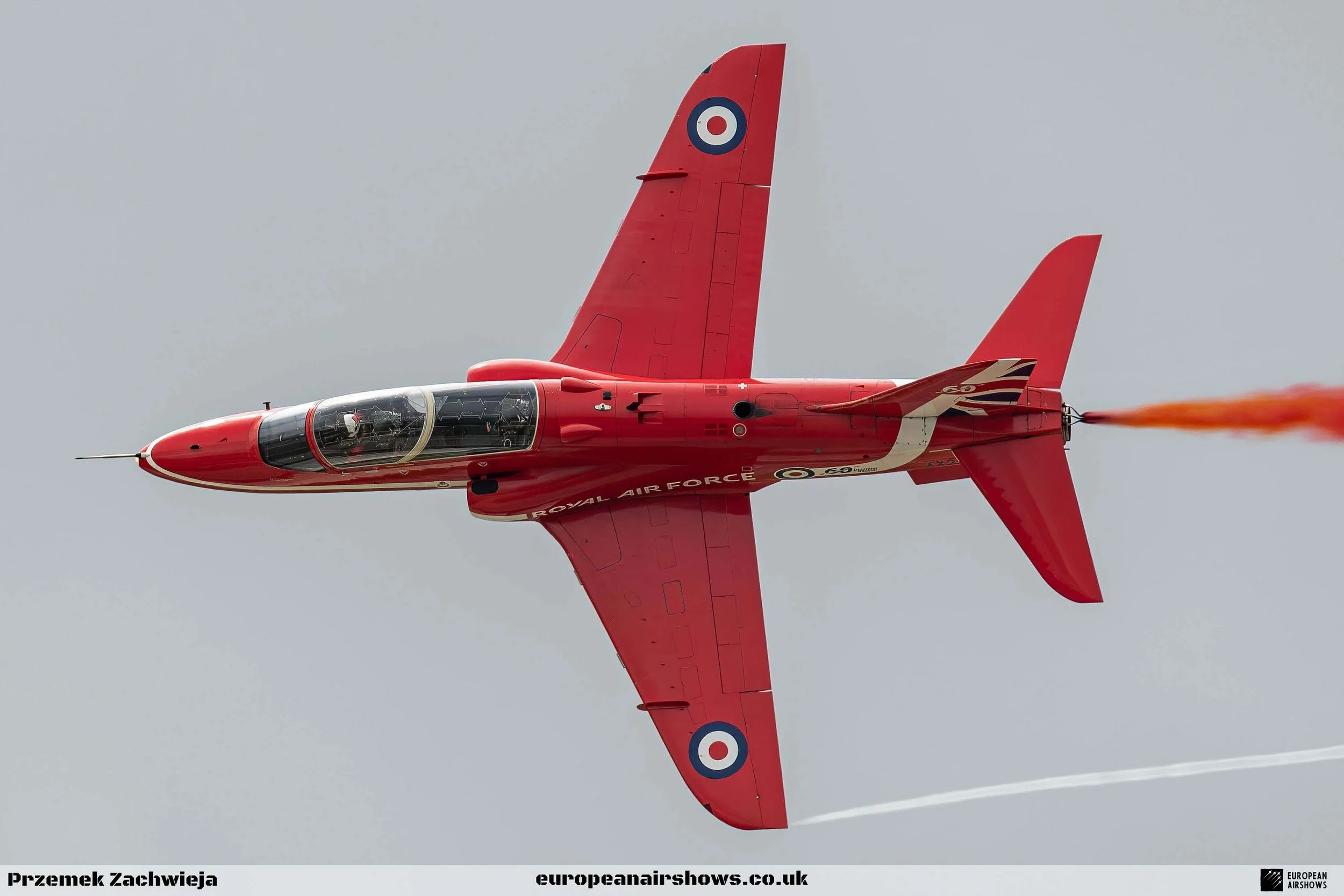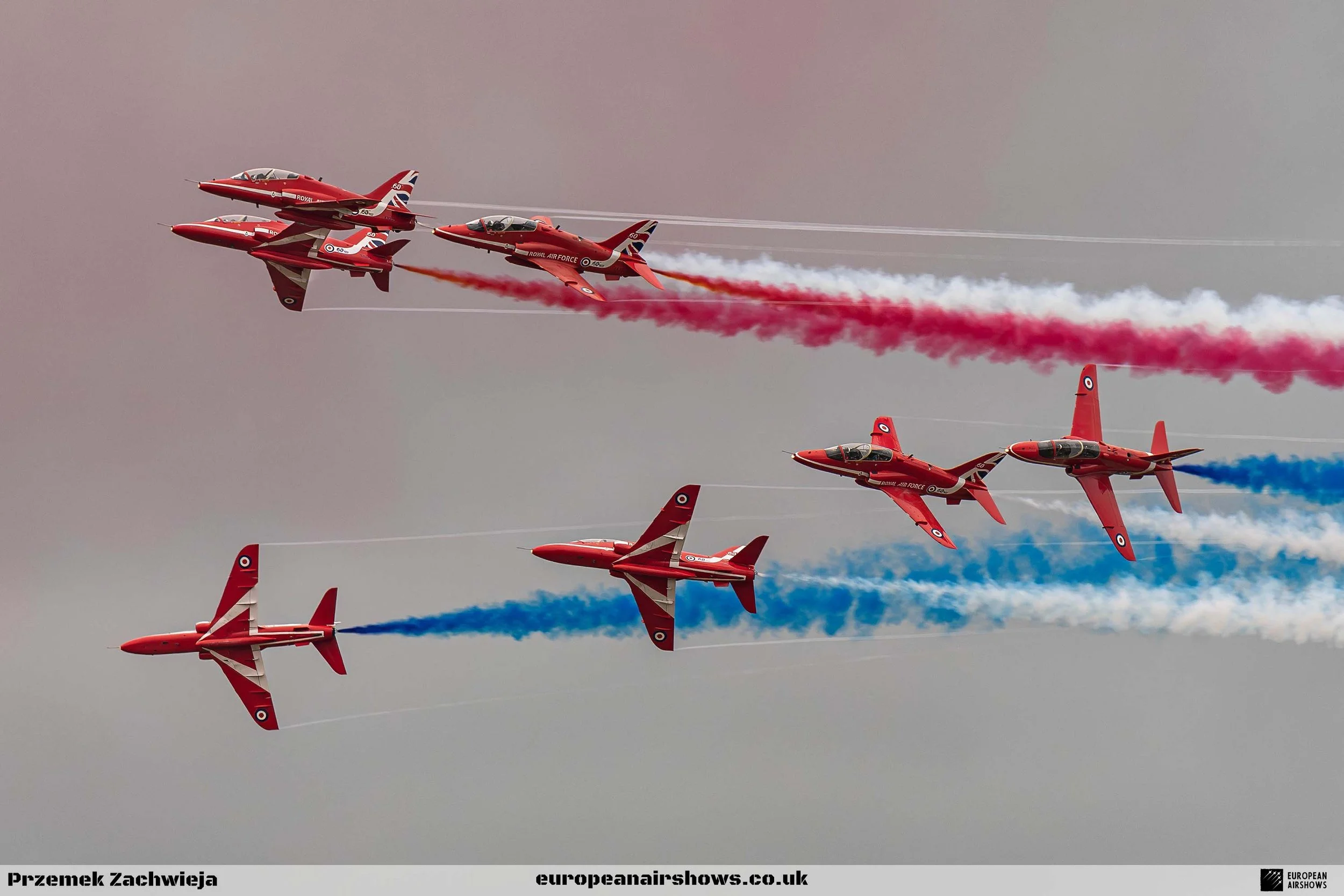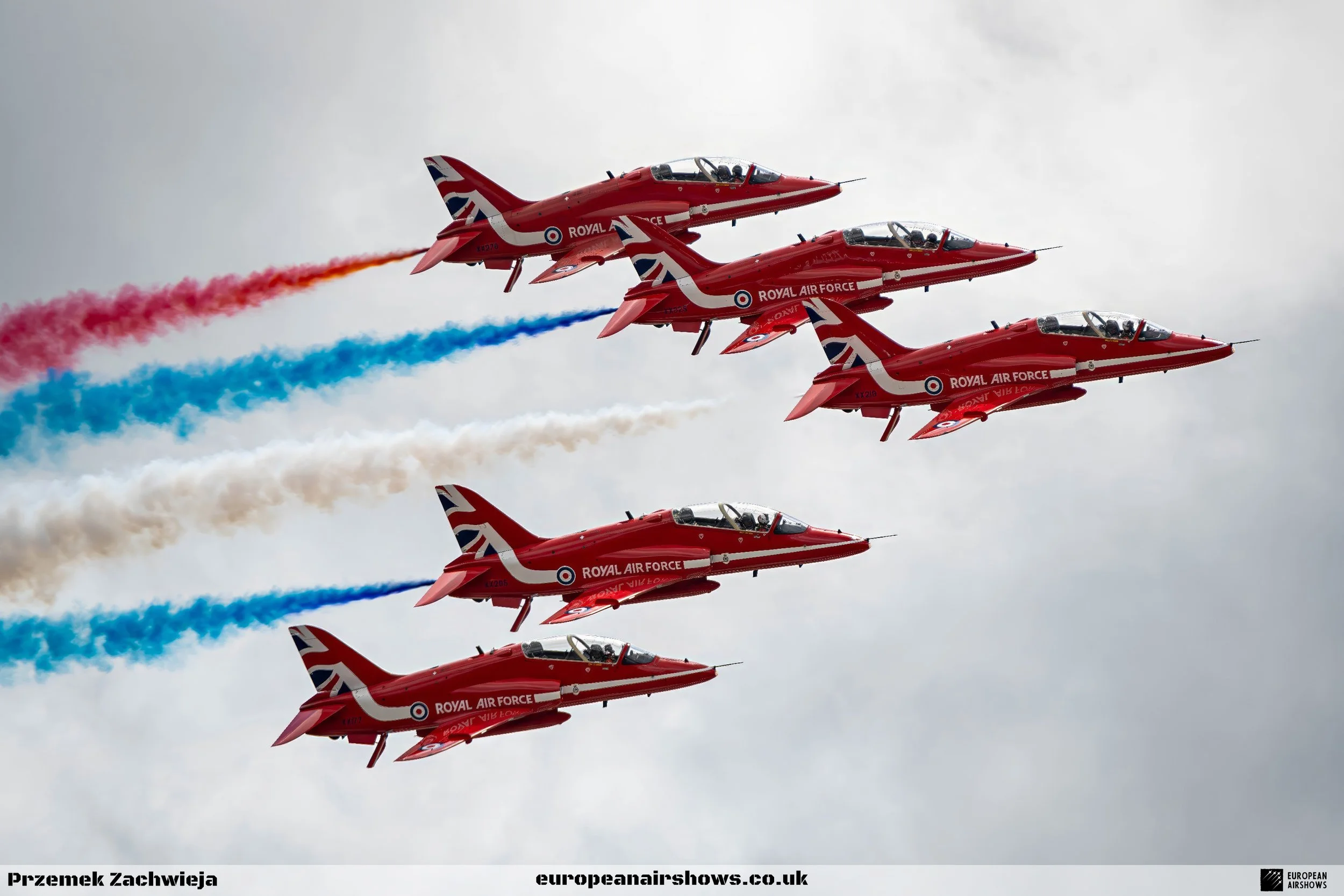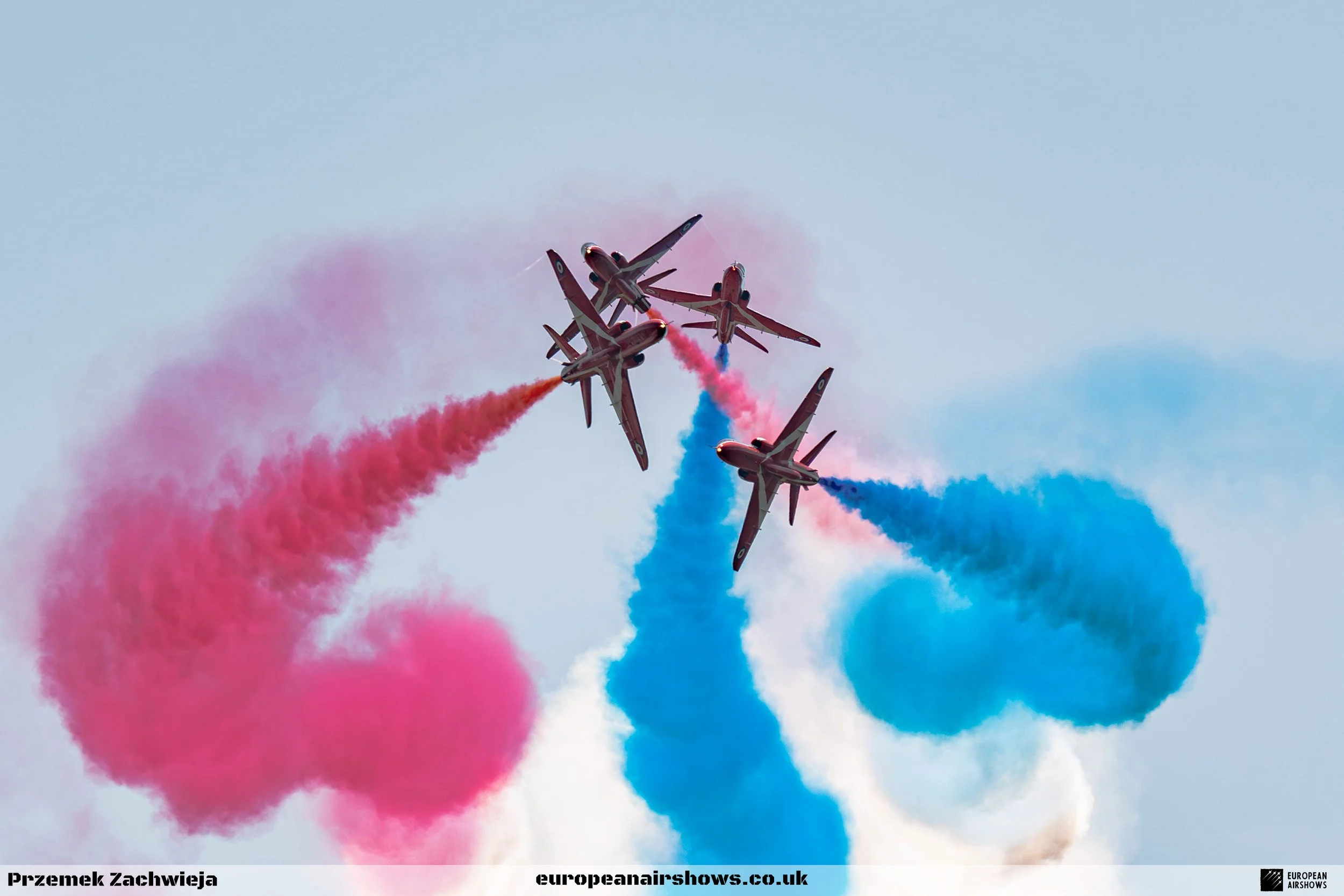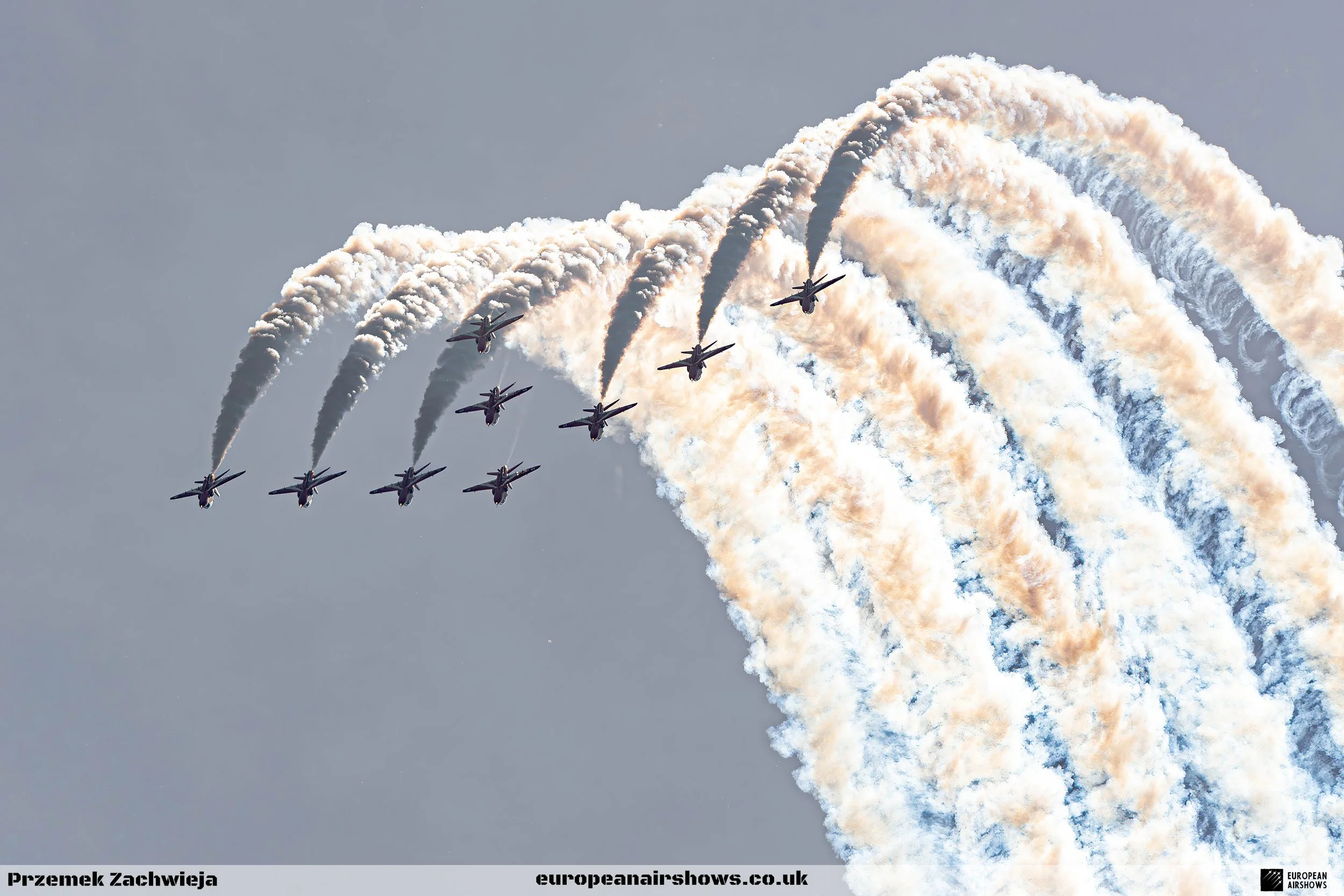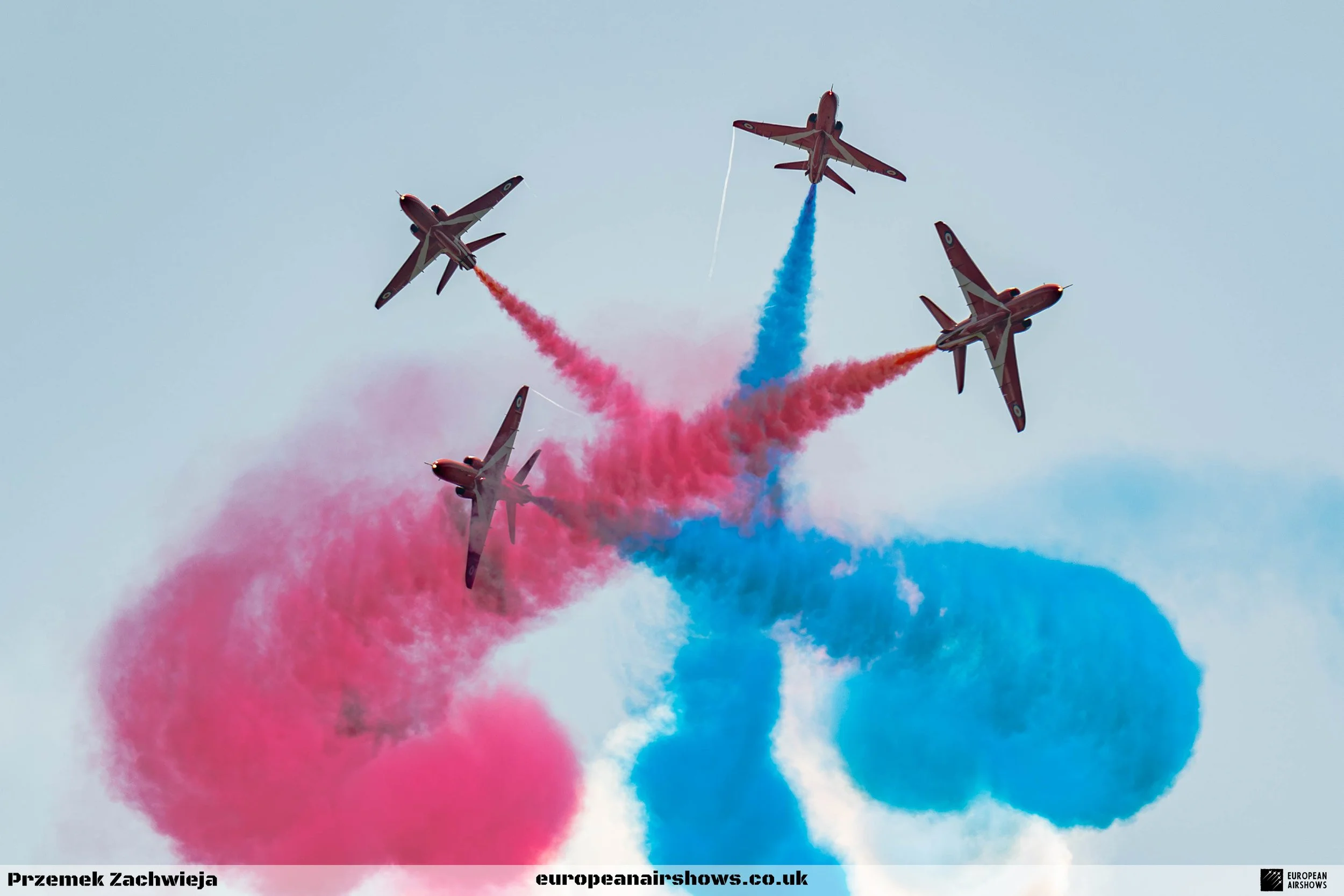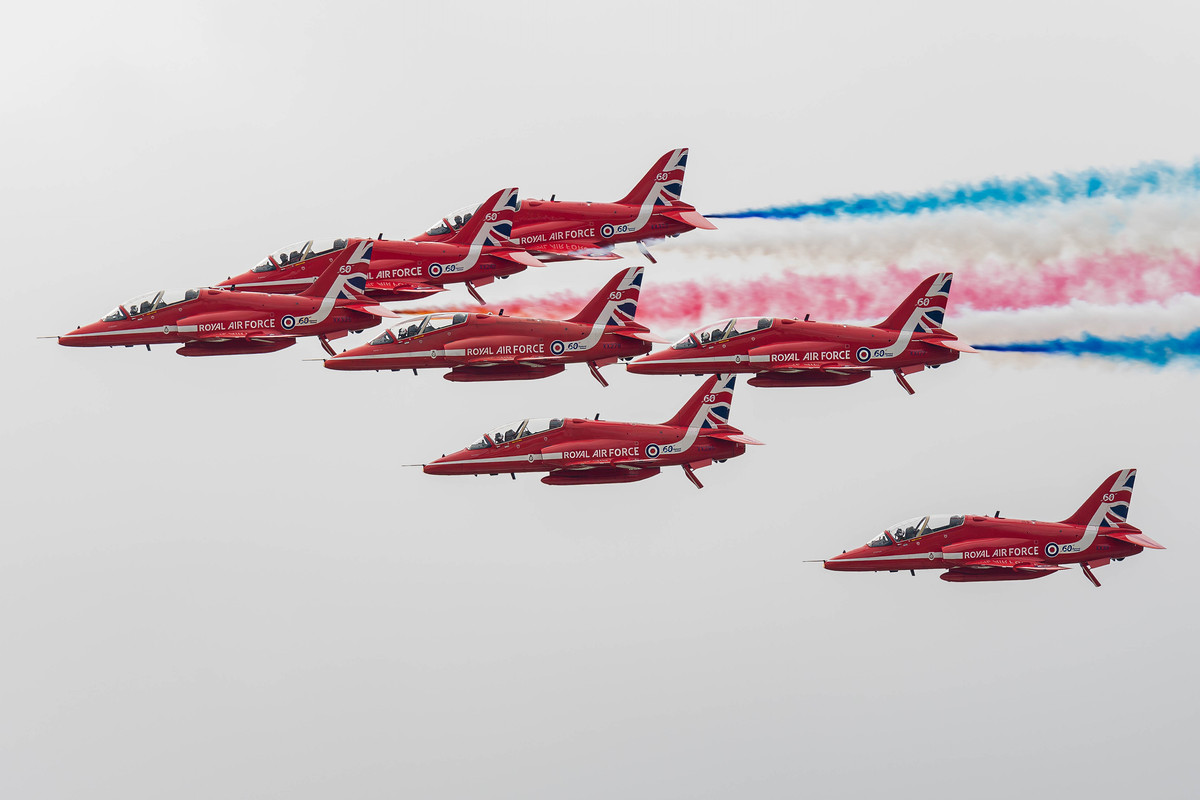
Red Arrows
About the Team
The Red Arrows, officially known as the Royal Air Force Aerobatic Team, represent the pinnacle of British aerobatic excellence. Based at RAF Waddington, the team was formed in late 1964 as an all-Royal Air Force unit, replacing several unofficial teams that had been sponsored by various RAF commands. Since their inception, the Red Arrows have become an integral part of British popular culture, with their spectacular aerobatic displays becoming a highlight of summer events across the UK and beyond. Their badge features the aircraft in their signature Diamond Nine formation, accompanied by the motto “Éclat,” a French word meaning “brilliance” or “excellence.”
The Red Arrows serve four primary roles: representing and showcasing the skills and values of the Royal Air Force, supporting British industry, assisting in defense diplomacy, and aiding recruitment for the UK Armed Forces. These roles highlight the team’s commitment not only to aerial artistry but also to promoting the RAF and its capabilities.
Initially, the team flew seven Folland Gnat trainers, which were chosen for their operational cost-effectiveness compared to front-line fighter aircraft. The Gnat proved to be an agile platform for aerobatic displays, allowing the pilots to perform intricate maneuvers. In their debut season, the Red Arrows completed 65 shows across Europe. The team expanded to nine aircraft in 1966, enabling the development of their iconic Diamond Nine formation, which has become synonymous with the Red Arrows’ identity. In late 1979, the team transitioned to the BAE Hawk trainer, which has since become the backbone of their operations. The Red Arrows have performed over 4,800 displays in 57 countries worldwide, captivating audiences with their precision and flair.
One of the most visually striking aspects of the Red Arrows’ performances is their use of colored smoke trails. The smoke system is a key feature of their displays, enhancing the visual impact and excitement of their aerial maneuvers. The smoke is created by injecting a mixture of diesel fuel and colored dye into the aircraft’s exhaust system. When the diesel vaporizes in the hot exhaust flow, it re-condenses into fine droplets, producing the characteristic smoke trails that the Red Arrows are known for. The aircraft are equipped with three tanks: one 50-imperial-gallon tank for pure diesel and two 10-imperial-gallon tanks for blue and red dyed diesel.
During a display, the smoke system can use up to 10 imperial gallons (approximately 45 liters) of diesel per minute. This allows each aircraft to produce smoke for about seven minutes—five minutes of white smoke, followed by one minute each of blue and red. The vibrant trails not only enhance the visual spectacle but also symbolize the colors of the Union Jack, adding a patriotic touch to their performances.
In a bid to align with environmental sustainability goals, the Ministry of Defence has sought to develop an environmentally friendly smoke system for the Red Arrows. This initiative is part of the broader RAF commitment to achieving net-zero emissions by 2040. The team has been exploring innovative solutions to reduce the environmental impact of their smoke generation while maintaining the visual appeal that audiences have come to expect.
The Red Arrows are composed of nine display pilots each season, all of whom are volunteers from the RAF. To be eligible for selection, pilots must have completed one or more operational tours on fast jets, accumulated a minimum of 1,500 flying hours, and demonstrated above-average performance in their operational role. The team typically sees more than ten pilots apply for each position. Pilots serve a three-year tour, with three pilots changing each year, ensuring a mix of experience within the team.
During displays, the Red Arrows are divided into two sections: Reds 1 to 5, known as “Enid,” and Reds 6 to 9, known as “Hanna.” The Enid section performs close-formation aerobatics, while the Hanna section executes more dynamic maneuvers, including the thrilling opposition passes of the Synchro Pair (Reds 6 and 7). The pilots experience significant g-forces during their performances, with forces reaching up to five times that of gravity (5g) and up to 7g during certain maneuvers like the Vixen Break.
The engineering and support team behind the Red Arrows, known as “The Blues,” comprises over 90 members from various technical and support trades within the RAF. This team is responsible for all aspects of aircraft maintenance, logistics, and display support, including the smoke systems that create the iconic trails. Each member of The Blues works closely with the pilots, ensuring that the aircraft are maintained to the highest standards and ready for each display.
The Red Arrows have become a beloved institution in British culture, their performances celebrated not only for their technical precision but also for their ability to inspire pride and admiration. Their displays are a testament to the skill, dedication, and teamwork of both the pilots and the support staff, making the Red Arrows a symbol of excellence in aviation.
Team Overview
Number of Aircraft
9
Established
1964
Based
RAF Waddington
Aircraft Type
BAE Systems Hawk T1A
About the aircraft
The BAE Systems Hawk T.1A is a modified variant of the original Hawk T1, specifically designed to replace the Hawker Hunter in the Royal Air Force’s Tactical Weapons Units. A total of 89 aircraft were converted to carry two underwing AIM-9L Sidewinder missiles and a centerline Aden gun pod. The Hawk T.1A is also utilized by the RAF’s Red Arrows display team, where the gun pod is replaced with a fairing for fuel and smoke dye.
First flown in 1974, the Hawk is a single-engine, jet-powered advanced trainer aircraft that features a two-man tandem cockpit, a low-mounted wing, and is powered by a Rolls-Royce Turbomeca Adour engine. It was designed for high serviceability and lower operational costs compared to previous trainers. The aircraft offers excellent agility and is capable of reaching speeds up to Mach 0.88 in level flight and Mach 1.15 in a dive, allowing trainee pilots to experience transonic flight.
The Hawk T.1A has a robust airframe, capable of withstanding +9 g, with a normal operational limit of +7.5/-4 g. It is equipped with dual hydraulic systems for various flight controls and safety features, including a ram air turbine for backup power. The aircraft can carry various armaments and equipment, making it versatile for both training and low-cost combat roles..
Team History
The history of the Red Arrows is rich and vibrant, beginning long before the team was officially formed. In 1920, the Royal Air Force (RAF) held its first pageant at Hendon, showcasing aerial displays from front-line biplane squadrons. This event captured the public’s imagination and set the stage for the future of aerobatic performances in the UK.
Fast forward to 1925, when No. 32 Squadron RAF made waves with a night-time display called “London Defended” at the British Empire Exhibition. This spectacular show featured RAF Sopwith Snipes painted in red, which were illuminated with white lights. The display was a dramatic affair, complete with firing blank ammunition into the stadium crowds and dropping pyrotechnics to simulate aerial combat. Among the pilots was Flying Officer C. W. A. Scott, who later gained fame for his record-breaking solo flights between England and Australia.
The post-war years ushered in the era of jet-powered aerobatics. In 1947, the first jet team, consisting of three de Havilland Vampires from RAF Odiham Fighter Wing, took to the skies. This marked a new chapter in aerobatic history as various teams began to experiment with jet aircraft. By 1950, No. 72 Squadron was showcasing a team of seven Vampires, and No. 54 Squadron became the first to incorporate smoke trails into their displays, adding a colorful flair to their performances. The introduction of the Hawker Hunter in 1955 further revolutionized aerobatic displays, with No. 54 Squadron performing impressive formations that captivated audiences.
In 1956, the official RAF aerobatic team was formed by No. 111 Squadron, which adopted an all-black color scheme and became known as “Les Fleches Noires” or “The Black Arrows.” This team achieved a remarkable feat in 1958, performing a loop and barrel roll with 22 Hawker Hunters—a world record for the largest number of aircraft looped in formation. The Black Arrows held the title of premier RAF aerobatic team until 1961, when the Blue Diamonds of No. 92 Squadron took over, flying 16 blue Hunters and captivating audiences with their own dynamic displays.
As the 1960s rolled in, the RAF recognized the need to consolidate its aerobatic teams. In 1964, the Red Pelicans, flying six BAC Jet Provosts, were the leading display team. At the same time, a team of five yellow Gnat trainers from No. 4 Flying Training School was making headlines at the Farnborough Airshow, eventually becoming known as the Yellowjacks. Concerns arose that pilots were spending too much time on formation aerobatics at the expense of operational training, leading to the decision to merge these various teams into a single, cohesive unit. This amalgamation birthed the Red Arrows, a name that combined the striking red color of the Pelicans with the legacy of the Black Arrows.
The Red Arrows officially began their journey on May 6, 1965, with a display at RAF Little Rissington, aimed at introducing the team to the media. Just days later, they performed their first public display at the French National Air Day in Clermont-Ferrand. The team quickly gained popularity, completing 65 shows across Europe in their inaugural season. By the end of that year, they earned the Britannia Trophy from the Royal Aero Club for their significant contributions to aviation, solidifying their status as a premier aerobatic team.
In 1966, under the leadership of Squadron Leader Ray Hanna, the team expanded from seven to nine aircraft, allowing them to develop the iconic Diamond Nine formation that has become synonymous with the Red Arrows. This change enhanced their performance capabilities and introduced a new level of complexity and artistry to their displays. Hanna’s leadership played a crucial role in shaping the team’s identity, and he became a celebrated figure in Red Arrows history, serving multiple terms as team leader and earning accolades for his exceptional flying skills.
The transition from the Folland Gnat to the BAE Hawk in 1979 marked another significant milestone for the Red Arrows. The Hawk, with its upgraded engine and enhanced capabilities, allowed the team to perform more dynamic and intricate maneuvers. Over the years, the Red Arrows traveled extensively, performing in over 57 countries and showcasing their unique brand of British excellence to international audiences. Their displays became a symbol of national pride, highlighting not only the skill of the pilots but also the technological advancements of the RAF.
Did You Know?
- The Red Arrows, the official aerobatic team of the Royal Air Force, were formed in 1964 and have performed over 4,800 displays in 57 countries.
- he team’s trademark formation is known as the Diamond Nine, and they are recognized for their vibrant red, white, and blue smoke trails during performances.
- The first female pilot to join the Red Arrows was Flt Lt Kirsty Moore in 2010, marking a significant milestone in the team’s history.
- The Red Arrows initially flew seven Folland Gnat trainers, which were less costly to operate than front-line fighters, before transitioning to the BAE Hawk in 1979.
- The Red Arrows are celebrating their 60th Diamond Season in 2024, which includes a special anniversary break maneuver in their displays.
Test Your Knowledge
1. When were the Red Arrows officially formed?
